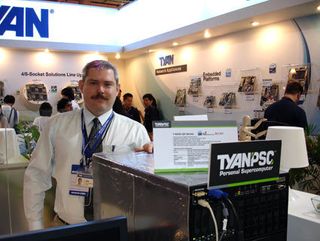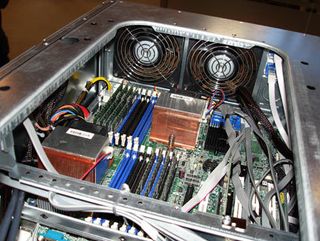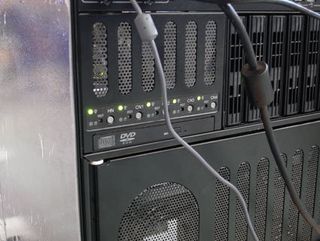Computex 2007: Mobility to Go Round, Boxed Supercomputing and the Redefinition of Video
Personal Supercomputing-in-a-Box By Tyan

Over in Hall 2, we had the opportunity to sit down with Tyan's John McClure. From a previous visit on day 2 we caught a glimpse of something we thought might be really cool, but it did not fit into the other days' coverage plans. With several patents of his own into the system, McClure took us on a tour of what can be described as a "Personal Supercomputer" or a cluster-in-a-box.
The T600 and T500 series PSCs can be a very valuable tool for engineers, graphics animators, researchers and anyone else who could use the extra computation power of their own personal computer or render farm. Most supercomputers have a sign-up list, as these solutions are expensive and typically shared among many clients. Those who use large clusters or render farms know the hassle it can be to configure the nodes in order for them to do what you want. Even with virtualization software, the real world "on hardware" can prove to be very different than a software virtualized configuration.
This hassle can be minimized or eliminated for power users on this system. The five nodes can manage up to 40 x86 processor cores, and this could be as high as 80 cores with future power configurations. This allows users to either run all of computations on their own systems, or hardware-simulate configurations on five nodes before running everything on the larger array.

The head node can support a professional grade graphics cards such as AMD/ATI FireGL or Nvidia Quadro in single or dual configuration, depending on the motherboard selected. Each of the compute nodes can support a single graphics card, but it must be mounted using a special riser and bracket system due to the overall system design. For graphics animators and game designers, software such as Maya allows the user to point the software to where the render farm is located. Using the Tyan PSC, the user can select the other four nodes inside the system as its render farm. This could save vast amounts of rendering time, and could even allow designers to manipulate their models in real time without having to scale back to a wireframe to do so.

The device could serve as many other things as well, such as a mobile branch or small business data center. While it is rather large for a portable system, it could certainly be used by engineers in the medical or oil and gas industry for data analysis and modeling. Game developers could test out client and server demands of current software builds. The user could set up a game server on one node and use the other nodes to make virtual clients to log into the server. A redundant pair could be utilized as a server when a game maker needs to provide additional servers for applications such as World of Warcraft.

The system McClure was configuring at the time of our meeting housed 3 x 600 W power supplies. One provides power to the head node, and the other two have their power combined and branched out across all of the other nodes. A KVM switch is located in the top of the case, so each of the compute nodes can be accessed individually. It comes configured with either a dual Gigabit Ethernet interconnect or with one Gigabit connection and a 4x Infiniband interface.
This is an interesting product because of the increased interest in super computing. The Tyan PSC fills current CPU compute for those looking for more power, but not that of a full-sized super computer, and it adds the flexibility of using "normal" commoditized hardware that keeps the cost down as well as making this unit run without specialized data center cooling. The possibility of adding a GPU to each node could add 3+ TFLOPs of additional compute power using current hardware.
Stay on the Cutting Edge
Join the experts who read Tom's Hardware for the inside track on enthusiast PC tech news — and have for over 25 years. We'll send breaking news and in-depth reviews of CPUs, GPUs, AI, maker hardware and more straight to your inbox.

Current page: Personal Supercomputing-in-a-Box By Tyan
Prev Page Supa GT-3000: GPS Tracker With Alert Next Page Silicon Optix / HQV: High-Grade HD For Smarter TV DesignsMost Popular

